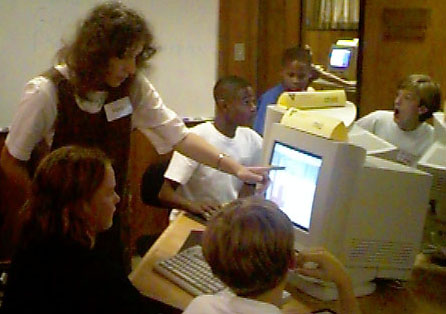|
The first day of the Math Exploration Club was another great start for this year's summer classes. Maria began the class by allowing the Shodor staff to introduce themselves. Shortly after this introduction the students were engrossed in a lesson on mathematical abuse. "Can anyone here recall a time when you [the explorers] noticed math abuse?" Maria asked the class. Math abuse, she explains, is when information appears legitimate at first but actually contains mathematical errors. Maria shows the students an example of math abuse using an article found in a national magazine. The article claimed to offer savings of over one hundred percent! Maria said this kind of mistake was an example of "math abuse," something which happens very often.
 Maria showed the class a tag from a shirt. The clothing tag listed that it was one hundred percent cotton, but also five percent lycra; students were quick to catch this error. One of the students thought that the clothing company tried to improve the customer view of the product by saying that it was of a higher quality than it actually was. Next, Maria gave the explorers fictitous data to be stored in a spreadsheet database. The Math Explorers created a bar chart using the data they created from their spreadsheets. This exercise was created to model the performance of two different companies. The explorers' job was to take the data given and to either make the performance of the company look constant or to make the performance of the company look erratic. They did this by changing the scale as well as the minimum and maximum default numbers. Finally, they printed their results in the form of a graph which they compared with the other students' graphs. The next worksheet involved a conman and a store clerk. The conman uses a large number of exchanges to confuse the clerk into giving him more than his due. The students' challenge was to discover where the extra money changed hands. The class then went on the web to try and define the word logic. Despite many false trails and bad links, one of the students found it in an online dictionary. This helped emphasize to the students that the internet does not contain easily accessible answers to everything, contrary to popular belief.
Last Update: June 22, 1998 Please direct questions and comments about this page to WebMaster@shodor.org © Copyright 1998 The Shodor Education Foundation, Inc. |

